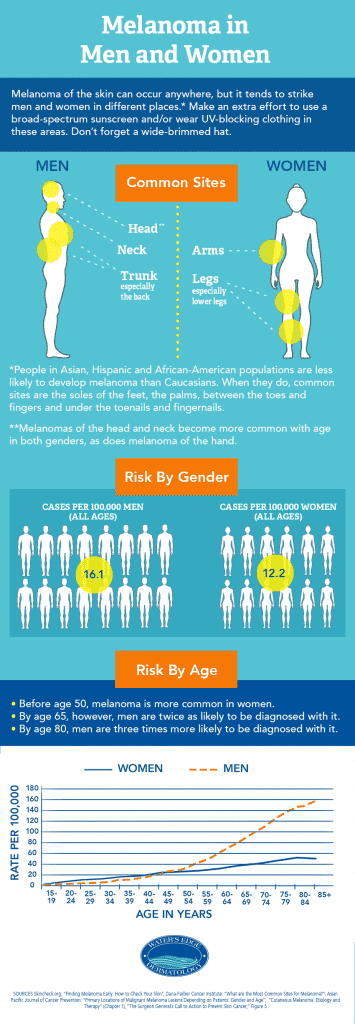 Men, especially those with lighter skin, are more likely than women to get skin cancer, including melanoma, the deadliest kind. They’re also much more likely to die of melanoma. Regular use of sunscreen reduces the risk of developing skin cancer by up to 50 percent. It also helps fend off wrinkles, age spots and leathery, weathered skin. But when it comes to sunscreen, many men haven’t seen the light.
Men, especially those with lighter skin, are more likely than women to get skin cancer, including melanoma, the deadliest kind. They’re also much more likely to die of melanoma. Regular use of sunscreen reduces the risk of developing skin cancer by up to 50 percent. It also helps fend off wrinkles, age spots and leathery, weathered skin. But when it comes to sunscreen, many men haven’t seen the light.
“Women are used to applying makeup and moisturizer, so they’re much more compliant about protecting their skin,”said Dr. Justin Platzer, MD, a board-certified dermatologist at Water’s Edge Dermatology. “It’s just not a priority for most men.”
Women’s sunscreen habits aren’t perfect, but compared to men, women are three times more likely to use sunscreen, according to one survey. That survey found that only about 18% of men regularly use sunscreen on their face or other exposed skin when they go outside on a warm, sunny day for more than an hour, and only about 14% use it on their face and their body.
Why are men so resistant to slathering on sun protection? For some, it may be an image issue — they view sunscreen as a “girly” beauty product. Others think they don’t need it. One survey found that nearly two-thirds of men believe women’s skin is more sensitive to ultraviolet (UV) rays. In reality, men’s skin is more likely than women’s skin to be damaged by UV rays.
Men also tend to be less enlightened than women about the dangers of sun exposure.
A survey conducted by the American Academy of Dermatology found that far fewer men than women know various facts about sun exposure, including that there’s no such thing as a healthy tan or that a base tan cannot protect against UV rays.
Finally, for some men, it’s a question of inconvenience. “It can be annoying to wear sunscreen and to apply and reapply it,” said Dr. Platzer. “It can be greasy and sweat into your eyes and make them burn.”
The good news about sunscreen: “It’s never too late to start using it,” said Dr. Platzer. When paired with other sun protection efforts, sunscreen can reduce the risk of skin cancer at any age.
Choose a product you will like and use
For men, finding a non-greasy product with staying power may be the key to sunscreen adoption. Dr. Platzer prefers EltaMD sunscreen for his face.
“It’s not greasy, is water resistant and comes in clear, so it won’t leave a white cast on the skin,” said Dr. Platzer. Clear sunscreens are a plus especially for men with darker skin. (Fast fact: Each year, nearly one in four Hispanic adults and one in 10 black adults experience at least one sunburn.) Water resistant means the product stays on the skin better when sweating and swimming. (It still needs to be reapplied every two hours.)
For the body, Dr. Platzer likes the convenience of spray sunscreen, but recommends rubbing it in (even if it’s a “no-rub” formula) to be sure skin is adequately covered. Gels are good for hairy areas such as the scalp or chest.
Choose a broad spectrum sunscreen to guard against both UVA rays (which contribute to skin aging and cancer) and UVB rays (responsible for burns). While an SPF of 30 is sufficient if you apply an adequate amount, most people don’t. “Since very few people apply enough sunscreen to get the full benefit of the SPF, using a higher SPF — 50 or 100 — means you’re more likely to get the protection you need,” said Dr. Platzer.
Use a lot, and in the right places
Some men dab on the thinnest possible layer of sunscreen, perhaps to avoid a greasy, heavy feeling. That won’t do much good. Think of a 1-ounce shot glass. That’s how much sunscreen you need to cover your face and body (approximately two tablespoons’ worth).
Pay special attention to areas commonly missed by men: the ears, eyelids, lips, back of the neck, tops of the feet and the scalp, where 13 percent of skin cancers occur. Men are more prone to skin cancer on the scalp and ears than women.
Can’t reach your back? Ask for help. The back is one of the most common places men develop melanoma.
Don’t wait until you’re on the beach or the boat to apply sunscreen. Apply it 30 minutes before you hit the great outdoors. Why? It needs time to bind to your skin.
Don’t make sunscreen do all the work
Sunscreen is essential, but it’s not a silver bullet. Use it in combination with other sun protection measures.
“I have a lot of patients who are swimmers or gardeners and are outside a lot,” said Dr. Platzer. “I tell them to go out in the morning or after the sun goes down to limit their exposure.”
If you’re a fisherman or boater or you live in state like Florida that gets near-constant sunshine, a wide-brimmed hat is a must, even if you wear sunscreen on your face and neck. Here’s a solution that lets you ease up on the sunscreen in other places: UV-blocking clothing. These shirts, pants and other garments block a certain percentage of UV radiation, as indicated by their ultraviolet protection factor (UPF). A garment with a UPF of 50 only lets 2% (1/50th) of UV rays through. By contrast, a typical white cotton T-shirt lets about 20% through.
“For male patients who won’t use sunscreen, wearing this clothing is the best thing they can do,” said Dr. Platzer. “Ideally, they’ll wear sunscreen too, but sun barrier clothing offers great protection.”
[su_quote]For male patients who won’t use sunscreen, wearing [sun protective] clothing is the best thing they can do.
[/su_quote]
Alternately, wear long sleeves and pants in dark colors when possible. If you opt for a baseball cap instead of a wide-brimmed hat, “be sure to cover your ears with sunscreen,” Dr. Platzer advised.
Learn from your mistakes
Many men are scared straight into using sunscreen. “Men who have a history of skin cancer tend to be more compliant,” Dr. Platzer said. But some remain resistant. “As soon as we cut out the skin cancer, they’re back getting sun.”
That often spells bad news, since about 60% of people who’ve had skin cancer will be diagnosed with a second occurrence within 10 years. If you’ve had one type of skin cancer, you’re also at increased risk for other types.
Article Written By: Karyn Repinski, a Brooklyn, NY-based award-winning health and beauty writer.
Medical Review By: Justin Platzer, MD






